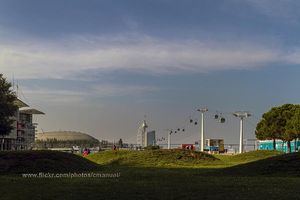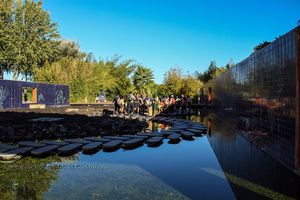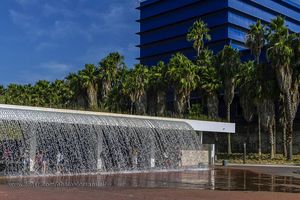
Parque das Nações Gardens, Lisbon
In an urban environment several gardens where included with worlwide inspiration which will make your 5 senses blossom.
One third of the area of Parque das Nações is green, and this is due to its beautiful gardens.
On the Northern region of the Towers Vasco da Gama you might find the five famous Garcia de Orta Gardens, a doctor and naturalist who dedicated his life to study plants and herbs from India.
These gardens reflect some of the landscapes and natural environments that the discoverers found during their trips. These gardens are divided into different areas: the African plot, the Macronesia plot, the S. Tomé and Brasil plot, the Goa plot and the Coloane plot which represents Meridional China. On these gardens you might find several plants as vines, tea plants, sugar cane, pepper, banana tree, mango tree, rice, bamboo and many others.
Near the river you might find the riverine pathway, also known as the “tágides” pathway, made by pine trees. Near this pathway you might find the Tágides Lake, an artificial lake with poetic figures imagined by Luis de Camoes, the most important portuguese poet, as the water goddesses. Sculptures were made by João Cutileiro.
On the central area of the Parque das Nações you’ll find the famous water volcanoes.
On the south region you’ll find the unique Water Gardens and the Palm trees garden, on the westside, composed by alternate queues of palm trees, a giraffe, a fountain (which represents a glacier) and a water channel, simulating a river. If you follow this river you’ll find the Mediterranean Garden and the Ulisses’ Lake where you might observe and listen to the beautiful sounds of the waterfall.
Behind the waterfall you’ll see the Hydraulic Garden, with several equipments and instruments which use the water motion to function and, nearby, the waves garden.
Finally, at the south there is, near the Marina, the Cabeço de Rolas Garden.
More information:
Location:
Parque das Nações, Lisboa
Recommended Excursions:
Mapa Interactivo:
Lisbon
What to see:
- Monuments
- Parks and Gardens
- Museums
- Viewpoints
- Baixa Pombalina / Rossio:
- Commerce Square
- Rossio Train Station
- Santa Justa Lift
- D. Maria II National Theatre
- Chiado:
- Carmo’s Archaeological Museum
- Chiado Museum
- Bairro Alto:
- São Pedro de Alcântara Viewpoint
- São Roque Museum
- National Museum of Natural History
- Alfama:
- São Jorge Castle
- Lisbon’s Cathedral
- National Pantheon
- Santa Luzia Viewpoint
- Fado Museum
- The Roman Theatre Museum (Museu do Teatro Romano)
- Saint Anthony Museum (Museu Antoniano)
- Nozzles House (Casa dos Bicos)
- Water Museum
- Azulejo (Tile) National Museum
- Museu Escola de Artes Decorativas Portuguesas
- Belém:
- Jerónimos Monastery
- Belem Tower
- Discoveries Pattern
- Carriages National Museum (Museu Nacional dos Coches)
- Calouste Gulbenkian Planetarium
- Berardo Collection Museum
- Belem Cultural Centre
- 25th April Bridge
- Afonso Albuquerque Garden
- Marine Museum
- National Archaeology Museum
- National Ethnology Museum
- National Palace of Ajuda (Palácio Nacional da Ajuda)
- Ajuda Botanic Garden (Jardim Botânico da Ajuda)
- Belém National Palace
- Electricity Museum
- Nations Park (Parque das Nações):
- Lisbon Oceanarium
- Knowledge Pavillion (Pavilhão do Conhecimento)
- Parque das Nações Gardens
- Vasco da Gama Bridge
- other places:
- Lisbon Zoological Garden
- Penha de França Viewpoint
- Bordalo Pinheiro Museum
- Olivais Pedagogical Farm
- Alto da Serafina Recreational Park
- Marquês de Pombal Square
- Palace of São Bento / Parliament
- Calouste Gulbenkian Foundation Building
- Arpad Szenes - Vieira da Silva Foundation
- City Museum (Museu da Cidade)
- Museum of the Scientific and Cultural Center of Macau
- Oriente Museum
- Music Museum
- Amália Rodrigues Garden
- Cold Greenhouse (Estufa Fria)
- Estrela Basilica
- Estrela Garden (Jardim da Estrela)
- Costumes National Museum (Museu Nacional do Traje)
- Cinema Museum (Cinemateca)
- Ancient Art National Museum (Museu Nacional de Arte Antiga)
- Eduardo VII Park
- Mirador da Graça
- Graça Viewpoint
- Senhora do Monte Viewpoint
- Free Waters Aqueduct
- Campo Pequeno Bullfight Arena
- Dom Afonso Henriques Avenue
- Restauradores Obelisk
- National Theatre Museum
What to do:
Why "Portugal Travel"?
Portugal Travel is an organization of Portuguese agencies whose objectives are:
- ✓ To make Portugal, its culture and its heritage known.
- ✓ To promote sustainable tourism.
In collaboration with:
Escola Superior de Hotelaria e Turismo do Estoril
Turismo de Portugal
Copyright PortugalTravel.org © - All rights reserved.






